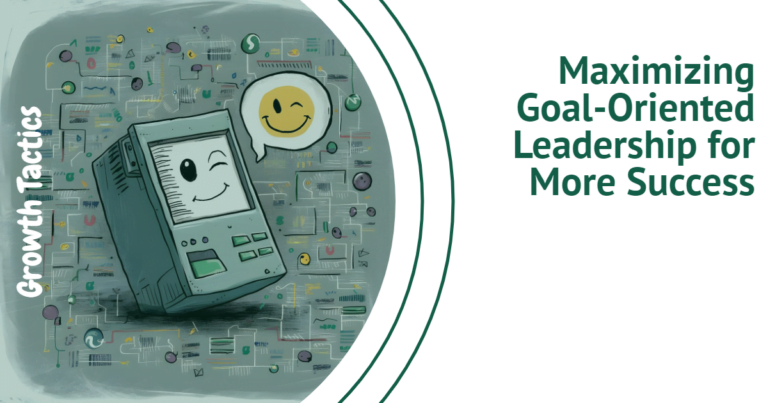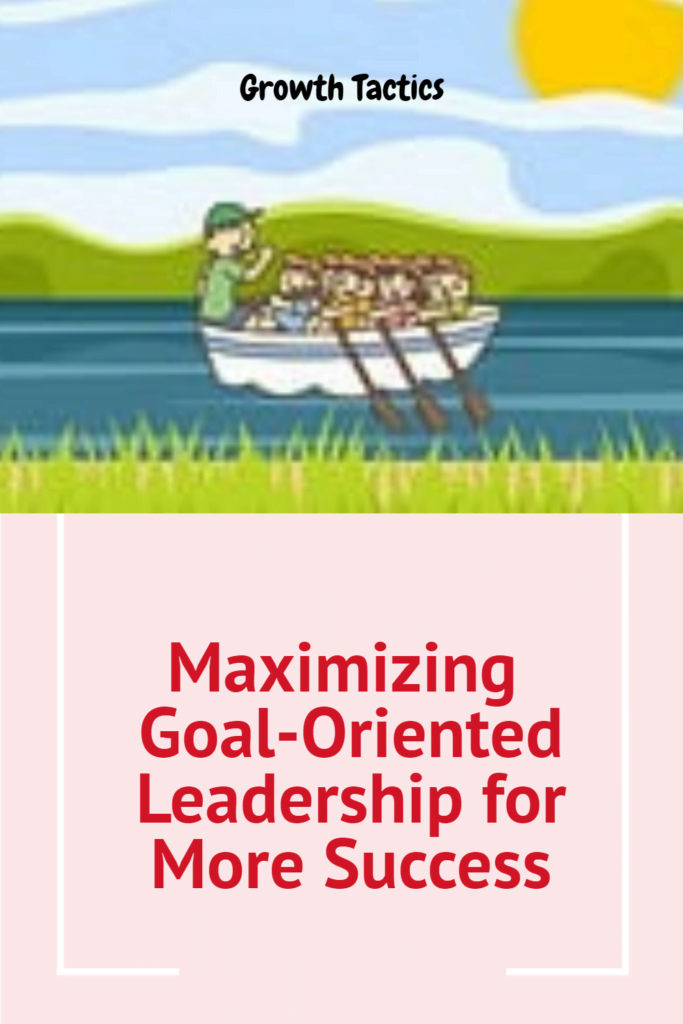In a world where ambition fuels progress, the art of leadership stands as the cornerstone to personal and collective triumph. Dive into the heart of success with “Maximizing Goal-Oriented Leadership for More Success,” where we unlock the secrets to elevating your leadership style, ensuring that every step taken is a leap towards achieving your most audacious goals. Get ready to transform potential into reality, as we embark on a journey to not just chase success, but to architect it.
Jump To Section
The Importance of Goal-Oriented Leadership
Goal-oriented leadership focuses on setting and achieving specific objectives that contribute to an organization’s overall success. This leadership style prioritizes measurable goals, clear timelines, and actionable strategies. Leaders drive their teams toward attaining defined goals and key results.
There are many benefits of goal-oriented leadership in the workplace. Firstly, it provides clarity of purpose, direction, and priorities for teams. When goals are concrete and specific, team members understand what they need to accomplish. This alignment ensures everyone is working towards the same end objectives.
Secondly, goal-oriented leadership improves productivity and efficiency. With clear goals, teams can organize tasks, allocate resources, and optimize processes accordingly. Leaders can monitor progress to keep work on track. Goals enable focus so teams don’t get distracted.
Thirdly, goal achievement provides a sense of collective purpose. Working towards common objectives unifies team members. Accomplishing goals creates shared feelings of success. This motivates and inspires team members to continue striving for more achievements.
While goal-oriented leadership has many upsides, it’s important not to become overly rigid and short-sighted. That’s why many leaders are shifting to a growth mindset by blending goal-oriented with growth-oriented leadership. More on making this change later in this article.
Setting Clear Goals and Vision
Effective leaders understand the importance of setting clear, specific goals that align with the organization’s overall vision and mission. Prioritizing the most vital goals is crucial. Goals should be measurable and have deadlines. When goals are precise and tied to a timeline, it creates focus and urgency. Leaders must communicate goals across the organization. Everyone needs to understand the objectives and work towards the same result.
Specifying concrete goals makes it easier to create strategies, allocate resources, and take actionable steps. Teams can break down big goals into smaller milestones. Progress can be tracked to keep momentum going. Leaders must remind teams to stay focused on achieving the goals as obstacles arise. Having clear goals brings focus and purpose to the workplace. It keeps everyone pointed toward a common destination.
Strategies for Achieving Goals

Strong goal-oriented leaders understand that setting objectives is only the first step. To accomplish goals, leaders need to have effective strategies and processes in place. Here are some key strategies for achieving goals in an organization:
Engaging and Motivating Team Members
- Communicate goals frequently to keep team members focused and inspired. Remind everyone of the “why” behind each goal.
- Make sure team members see how their work contributes to larger goals. This gives a sense of purpose.
- Celebrate milestones and wins along the way. Recognition motivates and boosts morale.
- Encourage collaboration and team bonding to build trust and enhance teamwork.
- Provide coaching and feedback to develop competencies. Invest in your team’s growth.
Developing Plans and Timelines
- Break down goals into manageable steps and set deadlines.
- Specify clear action plans listing tasks required to meet each goal.
- Prioritize goals and focus energy on top priorities first.
- Track progress frequently to identify potential roadblocks early.
- Be flexible and adjust timelines if needed while still maintaining urgency.
Tracking Progress and Metrics
- Identify key performance metrics to quantify progress towards goals.
- Set up systems to monitor metrics frequently and report to the team.
- Analyze results and trends to gain insights and make data-driven decisions.
- Course correct quickly if metrics indicate goals are at risk. Refine strategies as needed.
- Celebrate when metrics show success! Reinforce progress.
With thoughtful strategies that engage team members, develop detailed plans and track progress, leaders can maximize goal achievement. Aligning with goals is just the beginning – effective implementation, follow-through, and measurement are key to actually accomplishing objectives. Goal-oriented leaders make it happen!
Overcoming Obstacles and Barriers

Even the best-laid plans can run into obstacles. As a leader, it’s critical to anticipate potential barriers and have strategies ready to overcome them. Here are some tips for troubleshooting challenges:
- Conduct regular check-ins with the team to identify any emerging issues early on. Ask questions to learn where things might be stuck.
- Brainstorm solutions collaboratively. Get different perspectives on how to handle obstacles. Encourage flexibility and openness to adapt as needed.
- Focus on the end goal. If the original timeline or process isn’t working, be willing to modify the approach while still aiming for the objective.
- Communicate transparently about changes to keep everyone aligned. Explain why adjustments are being made.
- Don’t place blame if execution is lagging. Reframe setbacks as learning opportunities.
- Remain upbeat and encouraging. Express confidence in the team’s ability to find creative ways forward.
- Celebrate small wins and milestones along the way. Recognize efforts even when the finish line isn’t yet crossed.
The ability to pivot while staying focused on goals is a hallmark of effective leadership. Maintaining optimism and bringing people together to find solutions will help overcome almost any barrier. With persistence and flexibility, teams can achieve remarkable results.
Fostering Teamwork and Collaboration
Effective communication and feedback are integral to fostering teamwork and collaboration in the workplace. As a leader, keeping your team members informed, providing constructive feedback, and encouraging open dialogue allows ideas to flow freely. This creates an environment where everyone feels empowered to contribute to the collective goal.
Promoting innovation and creativity is also key. When team members feel psychologically safe to think outside the box, they will be more likely to come up with solutions and process improvements. As a leader, you can encourage this by allowing time for brainstorming, giving recognition for new ideas, and not shutting down suggestions too quickly. An innovative team is a productive team.
To foster teamwork and collaboration, it’s important to promote shared responsibility and accountability. Make sure team members understand how their roles contribute to the bigger picture. Recognize collective achievements in addition to individual ones. When the team succeeds together, they will be motivated to collaborate effectively.
Celebrating Successes
Recognizing achievements is an integral part of goal-oriented leadership. When goals are achieved, leaders need to acknowledge and celebrate these wins. This not only rewards the hard work of team members but also reinforces the behaviors and actions that led to success.
Publicly praising accomplishments at team meetings or company gatherings helps inspire ongoing motivation. It reminds everyone that their efforts matter and are contributing to something bigger. Celebrations demonstrate firsthand how goals are being attained.
Tying celebrations back to the original vision and goals also maintains focus on the bigger picture. Wins along the way are not the final objective. Recognizing milestones helps energize people to keep striving toward the ultimate aim.
Leaders should get creative with how they recognize achievements. Things like taking the team out for lunch, handing out awards, or posting kudos on the company intranet make success tangible. But the key is sincerity – showing team members their contributions are valued. This propels both individual and collective drive to continue excelling.
From Goal-Oriented to Growth-Oriented
It’s easy to get caught up in the day-to-day goals and objectives of a workplace. Managers and leaders often find themselves focused solely on short-term goals, deadlines, and achievements. However, the most effective leaders understand the importance of shifting from a goal-oriented mindset to a growth-oriented one.
What does this shift in mindset look like? It requires an ongoing focus on development, improvement, and expanding opportunities – for both individual team members and the organization as a whole.
Goal-oriented leaders aim to accomplish tasks, meet deadlines, and gain skills. Growth-oriented leaders, on the other hand, aim to identify potential, nurture talent, and contribute to the collective growth of the team. This means taking a long-term perspective and understanding that wins and losses are all part of a bigger picture.
Some strategies for making the shift from goal to growth focus include:
- Coaching team members for improved competency, productivity, and job satisfaction. Effective coaching shows employees their growth potential.
- Collaborating with team members to set goals focused on organizational improvement and innovation vs. only individual achievement.
- Providing opportunities for team members to enhance skills, take on new challenges, and expand responsibilities. This expands their capabilities over time.
- Setting aside time for team reflection, assessment, and analysis of strengths, weaknesses, and growth areas.
- Identifying and developing rising talent within the organization. This ensures a pipeline of future leaders.
- Celebrating and recognizing achievements focused on teamwork, creativity, and learning – not just task completion.
With an emphasis on ongoing development, improvement, and expanded potential, leaders can shift successfully from goal-oriented to growth-oriented. This enables greater organizational success over time.
Coaching and Developing for the Future

Great leaders understand that success depends on continual growth and improvement. They make coaching and developing team members a top priority. Here are some key ways goal-oriented leaders can enable future success through coaching:
Identifying Areas for Growth
Leaders need to regularly assess team members’ strengths and opportunities for improvement. Annual reviews are useful, but more frequent check-ins allow for timely feedback and support. Leaders should have regular one-on-one meetings to discuss development areas and collaborate on growth plans. They can use tools like skill matrixes, training needs assessments, and performance reviews to pinpoint priorities. The most effective leaders turn development into an ongoing conversation.
Providing Training and Mentoring
Once development areas are identified, leaders must provide resources and support. This includes formal training like workshops or online courses. Leaders should also consider job shadowing, stretch assignments, and rotations to build experience. Mentoring helps transfer institutional knowledge. Leaders can mentor team members directly or facilitate mentorships. Setting up peer mentoring enables employees to learn from each other. Ongoing training and mentoring are key for continuous improvement.
Succession Planning
Savvy leaders prepare for the future by identifying and developing talent to fill key roles down the road. They create succession plans that outline personnel needs, highlight rising stars, and map development plans. Leaders collaborate with HR on programs like high-potential tracks to give promising employees visibility and accelerated development. Robust succession planning ensures continuity, retains institutional knowledge and enables smooth leadership transitions. It gives employees development opportunities and career paths.
The Impact of Goal-Oriented Leadership
Goal-oriented leadership has a significant impact on an organization’s performance and culture. When implemented effectively, it can lead to increased productivity, higher engagement, and overall success.
Increased Productivity and Performance
With clear objectives and metrics, teams can focus their efforts on the tasks that matter most. Leaders can monitor progress and make course corrections as needed. This leads to improved efficiency and ensures work is contributing to strategic goals. Studies show that goal-setting boosts productivity by up to 25%.
Higher Engagement and Satisfaction
Goals give team members purpose and motivate them to push themselves. Achieving milestones provides a sense of accomplishment. This intrinsic motivation leads to greater engagement. Employees feel their work is meaningful when it aligns with company objectives.
Achieving Organizational Success
Well-executed goals at the team and individual levels ladder up to overall organizational success. By linking goals throughout the company, everyone is working towards the same vision. This unity of purpose allows for strategy execution. Companies that are disciplined in goal-setting tend to outperform competitors.
Start Maximizing Goal-Oriented Leadership
Maximizing goal-oriented leadership starts with understanding the importance of setting clear goals and having a vision for the future. As a leader, you need to identify objectives, create strategies, and foster an environment where your team can accomplish those goals.
Here are some steps to start maximizing goal-oriented leadership:
Set Specific Goals
- Identify short and long-term goals
- Make goals measurable and achievable
- Align goals to overall vision and mission
Communicate Goals
- Share goals with team members
- Explain why goals matter and how they contribute to success
- Get team buy-in and input on goals
Create Strategies
- Break down goals into actionable steps
- Assign tasks and deadlines
- Determine needed resources and support systems
Motivate and Support Your Team
- Inspire team commitment to goals
- Provide coaching and remove obstacles
- Celebrate small wins along the way
Measure Progress
- Track progress toward goals
- Re-evaluate and adjust strategies as needed
- Analyze results and learn from experience
Transition to Growth-Oriented Mindset
- Shift focus from achieving goals to developing people
- Empower team members to take ownership
- Foster continuous learning and improvement
By implementing these steps, you can maximize a goal-oriented approach while also developing your team. Leadership is a journey, not a destination. Evaluate your progress and evolve your strategies over time.


